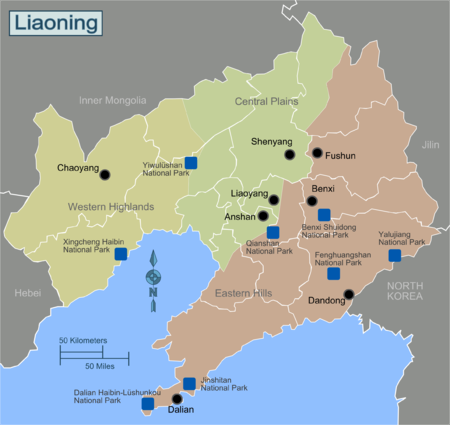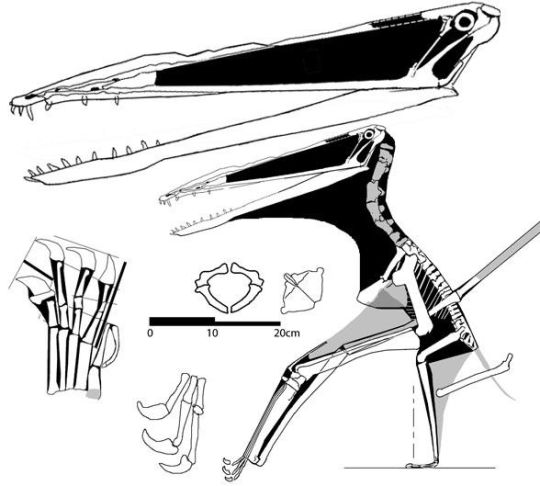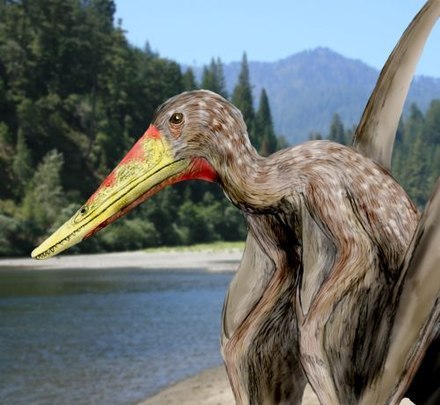#ornithocheiroid
Explore tagged Tumblr posts
Text
"Early pterosaurs were bad on land you say?" nah

A recent study concluded that early pterosaurs were arboreal and incapable of moving efficiently on the ground, with derived pterodactyloids being more efficient walkers. This is a traditional view on pterosaur evolution... which ignores a study that has concluded that early pterosaurs were efficient on the ground as well, as well as flat out ignoring a study showing non-pterodactyloid Rhamphichnus trackways (though granted, one study finds them to be non-pterosaurian).
I will say, this study does offer interesting prospects, including that most non-pteranodontian ornithocheiroids* were arboreal, which is a goldmine for paleoart. But I can't stand seeing so many studies disregarded to arrive at this paper's conclusion.
*as in, actual ornithocheiroids, and not the Kellner definition as Pteranodontia + Dsungaripteroidea + Azhdarchoidea. Feels so good to use it in the proper context again!
In the end? Maybe early pterosaurs were more arboreal than pterodactyloids on average. But they were no slops on the ground.
9 notes
·
View notes
Text
A new pterosaur specimen from the Lower Cretaceous Yixian Formation of Liaoning Province, China: The oldest fossil record of Nurhachius
Published 28th June 2023
A new fossil specimen of the Istiodactylidae Nurhachius from the Liaoning Province.

Image of the Liaoning Province, from Wikitravel.

Nurhachius ignaciobritoi described 6th October 2005.

Nurhachius luei holotype (BPMC-0204), described 19th September 2019.
Nurhachius is an almost mature pterosaur with an estimated wingspan of 1.6 m and is geologically the oldest known occurrence of Nurhachius. The istiodactylidae is a new component of the pterosaur assemblage of the Jingangshan Member, and provides new information on the pelvis and hindlimb of istiodactylids and the palaeobiology of this clade. A great discovery that provides more information for the pterosaurs in China.

Skeletal reconstruction of Nurhachius, from:
note that this reconstruction may not be reliable or accurate and may be a speculative/innovative creative vision of Nurhachius' appearance (note added in response to feedback, thank you! I'll make sure to include disclaimers/warnings in the future for less trustworthy sources)

Paleo art of Nurhachius, on Wikipedia.
Source:
read the paper for more information.
36 notes
·
View notes
Text

Archovember Day 15: Anhanguera piscator
Anhanguera pisator is a pterodactyloid pterosaur from Early Cretaceous Brazil (lots of Brazilian pterosaurs this year, huh? I swear I did not plan that.)
A. piscator was a fish-eater with a wingspan of around 15 feet, and would have been the size of a medium dog when on all fours. It had a big gnarly spoonbill like other ornithocheiroids, however its jaws were more slender than its relatives.
There are at least two species of Anhanguera, and while A. blittersdorfi is the type species, I chose A. piscator as we have a nearly complete skeleton of it.
#my art#Anhanguera piscator#Anhanguera#Pterodactyloids#Ornithocheiroids#pterosaurs#archosaurs#archosauromorphs#Archovember#Archovember 2021#Dinovember#Dinovember 2021#Draw Dinovember#Draw Dinovember 2021#SaritaDrawsPalaeo
31 notes
·
View notes
Text
Aussiedraco
Aussiedraco is a genus of basal ornithocheiroid pterodactyloid pterosaur from the early Cretaceous of Australia. Aussiedraco is known from holotype QM F10613, a partial mandibular symphysis housed at the Queensland Museum, recovered from rocks of the Toolebuc Formation, about 70 km east of Boulia, western Queensland, dating to Albian stage. It was named by Alexander W.A. Kellner, Taissa Rodrigues and Fabiana R. Costa in 2011 and the type species is Aussiedraco molnari. The generic name is derived from "Aussie", a shortened form of Australian, and "draco", from Latin meaning dragon. The specific epithet honours Ralph E. Molnar, who first described the specimen in 1980. The symphysis fragment is 88 millimetres long and very straight and narrow, with a lanceolate not-expanded tip and triangular cross-section. It lacks a keel or crest and is convex on top, with a median narrow deep groove not reaching the tip, but flat at the bottom. As far as can be judged from the empty elliptical tooth-sockets, the lower jaws carry at least five pairs of teeth, which are rather large and become more outwards inclining and procumbent towards the front. Aussiedraco is estimated to have been smaller in size than Mythunga, a pterosaur from the same formation. Kellner e.a. assigned Aussiedraco to the Pteranodontoidea, a clade roughly containing the same species as the Ornithocheiroidea sensu Unwin. Aussiedraco would be closely related to the Anhangueridae. More details Android, Windows
0 notes
Photo

Pteranodon plushie by IsisMasshiro:
A Pteranodon longiceps I made, which is based on this picture [link] This is actually a painted miniplushie with brass wires in its wings. Wingspan is 36 cm.
#pterosaur#pterodactyl#pteranodon#pteranodontid#ornithocheiroid#pterodactyloid#fun is allowed on this blog
167 notes
·
View notes